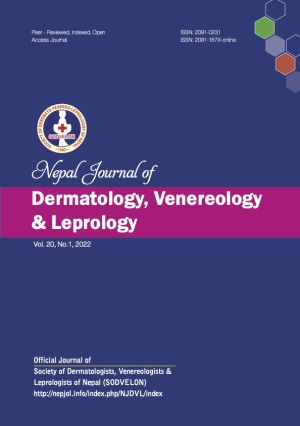Clinico-Histopathological Study of Cicatricial Alopecia in a Tertiary Care Center
DOI:
https://doi.org/10.3126/njdvl.v20i1.38206Keywords:
Alopecia, Cicatrix, PathologyAbstract
Introduction: Cicatricial alopecia (CA) comprises a group of disorders characterized by permanent destruction of the hair follicle and fibrosis on histopathologic examination. The similarities in the clinical presentation of various types of this disorder cause difficulty in prompt diagnosis, so histopathological assessment plays a pivotal role in the diagnosis.
Objectives: This study aimed to assess the clinical variants of cicatricial alopecia and compare the histopathology of the various subtypes.
Materials and Methods: In this cross-sectional study, 22 patients of cicatricial alopecia were enrolled and punch biopsies from the active site were taken for histopathological examination. Statistical analysis and correlation of clinical and histopathological features were done.
Results: Out of the 22 patients, 10 cases (45.45%) were confirmed as Lichen Planopilaris (LPP), seven (31.81%) as Discoid Lupus Erythematosus (DLE), two (9%) as Morphea, one (4.5%) each as Pseudopelade, Central Centrifugal Cicatricial Alopecia (CCCA) and Dissecting cellulitis (DC). There was a fair agreement between clinical and histopathological diagnoses (Kappa=0.384). The age ranged from 10 years to 60 years with the mean age of 32.32 ± 15.51 years.
Conclusion: There is high clinical and histopathological variability and similarities among the variants of CA, which represents a true diagnostic challenge. A precise and early diagnosis is possible if the clinico-histopathological correlation is employed.
Downloads
Downloads
Published
How to Cite
Issue
Section
License
Copyright (c) 2022 Society of Dermatologists, Venereologists and Leprologists of Nepal

This work is licensed under a Creative Commons Attribution 4.0 International License.
Copyright on any research article is transferred in full to Nepal Journal of Dermatology, Venereology & Leprology upon publication. The copyright transfer includes the right to reproduce and distribute the article in any form of reproduction (printing, electronic media or any other form).




